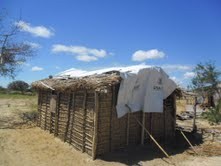
After cyclone Haruna, the United States stands by the people of Madagascar
For Immediate Release
Antananarivo, Madagascar – In the immediate aftermath of Tropical Cyclone Haruna, which struck Madagascar’s exposed and populated southwest coast as a category two cyclone on 22 February, the United States Government has announced it will provide U.S. $50,000 in emergency relief to provide material assistance for cyclone victims.
Funds will be provided to an international non-governmental organization to support post-storm immediate recovery activities and the distribution of relief supplies. “This assistance can be used immediately by our partners on the ground to provide essential hygiene kits and plastic sheeting in the coming days and weeks,” explained USAID/Madagascar Health, Population and Nutrition office director Aleathea Musah. “We will continue to work with our partners to determine the needs of the local population.”
Tropical Cyclone Haruna made landfall near Morombe, with winds up to 150 miles/hour. Initial reports describe significant damage in the large port city of Tulear and surrounding areas. The cyclone brought heavy rains that caused significant flooding and devastation to large swaths of land, especially in the southwest and southern parts of the country. The United States stands by the people of Madagascar and extends condolences to those affected by Cyclone Haruna.
According to the Madagascar national disaster management office (Bureau National de Gestion des Risques et des Catastrophes, BNGRC), over 22,000 people have been affected and 9,965 are homeless. At least 23 people have been killed and 1,500 ha of rice fields have been flooded, with potential severe consequences for food security in the affected zones.
The U.S. Government, through USAID and its partners, will move quickly to distribute plastic sheeting, disaster relief supplies and hygiene kits in the affected areas, which may include the following regions: Sakaraha, Bekily, Amboasary, Beloha, Tsihombe, Ambovombe, Taolagnaro, Morondava, Ankazoabo, Benenitra and Manja. Madagascar is extremely vulnerable to floods and cyclones during the rainy season, which stretches from October to April.
The U.S. Government response to Cyclone Haruna is consistent with the commitment of the American people to provide assistance to the most vulnerable in Madagascar. The United States continues to provide more aid to the Malagasy people than any other nation. This year, USAID is providing U.S. $66 million of assistance to the Malagasy people with programs that include investments in health, food security, and emergency services programs. In addition, the Peace Corps has over 130 volunteers currently living and working in some of the poorest and most remote regions of the country.







Comment
Make a general inquiry or suggest an improvement.